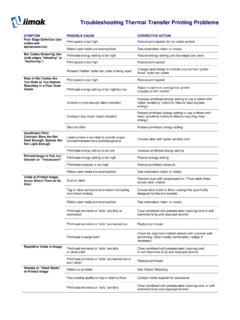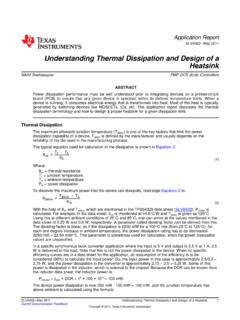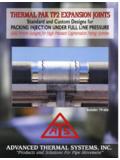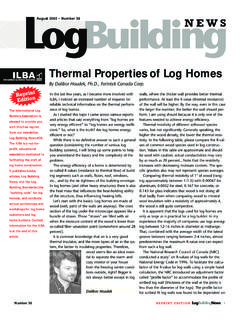Transcription of Superior Thermal Conductivity of Single-Layer …
1 NANO. LETTERS. Superior Thermal Conductivity of 2008. Vol. 8, No. 3. Single-Layer graphene 902-907. Alexander A. Balandin,*, , Suchismita Ghosh, Wenzhong Bao, Irene Calizo, . Desalegne Teweldebrhan, Feng Miao, and Chun Ning Lau . Nano-DeVice Laboratory, Department of Electrical Engineering, UniVersity of California-RiVerside, RiVerside, California 92521, Materials Science and Engineering Program, Bourns College of Engineering, UniVersity of California-RiVerside, RiVerside, California 92521, Department of Physics and Astronomy, UniVersity of California-RiVerside, RiVerside, California 92521. Received December 5, 2007; Revised Manuscript Received January 15, 2008. ABSTRACT. We report the measurement of the Thermal Conductivity of a suspended Single-Layer graphene . The room temperature values of the Thermal Conductivity in the range ( ( ) 103 to ( ( ) 103 W/mK were extracted for a Single-Layer graphene from the dependence of the Raman G peak frequency on the excitation laser power and independently measured G peak temperature coefficient.))
2 The extremely high value of the Thermal Conductivity suggests that graphene can outperform carbon nanotubes in heat conduction. The superb Thermal conduction property of graphene is beneficial for the proposed electronic applications and establishes graphene as an excellent material for Thermal management. graphene , a recently discovered form of carbon1 that consists graphene from the dependence of the Raman G peak of only one plain layer of atoms arranged in a honeycomb frequency on the excitation laser power. The extremely high lattice, exhibits a number of intriguing 8 The values of the Thermal Conductivity suggest that graphene can unusual energy dispersion relation, the low-lying electrons outperform carbon nanotubes (CNTs) in heat conduction. The in Single-Layer graphene behave like massless relativistic superb thermally conducting property of graphene is ben- Dirac fermions, gives rise to unique phenomena such as eficial for the proposed electronic applications and establishes quantum spin Hall effect,2,3 enhanced Coulomb interaction,3 5 graphene as an excellent material for Thermal management.
3 Suppression of the weak localization,6 and deviation from The discovered outstanding Thermal properties of graphene the adiabatic Born Oppenheimer Its ex- provide an extra motivation for graphene integration with traordinary high room temperature (RT) carrier mobility,1,8 the nanometer-scale silicon complementary metal-oxide- conductance quantization5 possibilities of inducing a band semiconductor (CMOS) technology as well as beyond- gap through the lateral quantum confinement,8 and prospects CMOS devices and circuits. Furthermore, it increases the for epitaxial growth9 make graphene a promising material range of graphene applications as the Thermal management for future electronic circuits. Despite theoretical suggestions material in optoelectronics, photonics, and bioengineering.
4 That graphene may also have unusually high Thermal con- With the continuously decreasing size of electronic devices ductivity,10 12 no measurements were reported to date to and increasing dissipation power density in downscaled support this claim. circuits, one observes a tremendous growth of importance In this letter, we report the first experimental investigation of Thermal conduction in a suspended Single-Layer graphene of materials that can conduct heat efficiently. CNTs are performed with the help of confocal micro-Raman spectros- known to have very high Thermal conductivity13,14 K with copy. The room temperature values of the Thermal conduc- the experimentally determined RT value K 3000 W/mK. tivity of up to 5300 W/mK were extracted for a Single-Layer for an individual multiwall carbon nanotube (MW-CNT)15.
5 And K 3500 W/mK for an individual single -wall carbon * Corresponding author. E-mail: Web address: nanotube (SW-CNT).16 The RT Thermal Conductivity in the Nano-Device Laboratory, Department of Electrical Engineering, Uni- range 1750-5800 W/mK was reported for the crystalline versity of California-Riverside. ropes of These values exceed those of the Materials Science and Engineering Program, Bourns College of best bulk crystalline Thermal conductor, diamond, which has Engineering, University of California-Riverside. Department of Physics and Astronomy, University of California- the Thermal Conductivity in the range K ) 1000 2200. Riverside. Theoretical calculations of the Thermal Conductivity CCC: $ 2008 American Chemical Society Published on Web 02/20/2008. of CNTs mostly support the experimental results for indi- vidual CNTs, although some discrepancy exists.
6 Molecular dynamics (MD) simulations suggested an unusually high value, K 6600 W/mK, for an insolated CNT at Another MD study found RT Thermal Conductivity in the range 1500 3000 W/mK for The same MD. calculations suggested that the Thermal Conductivity of graphene , a single plane layer of carbon atoms, would be even higher. In spite of the fundamental science and practical impor- tance of the knowledge about the Thermal Conductivity of graphene , no experimental data has been reported to date. The latter can be explained by the fact that the conventional techniques for measuring the Thermal Conductivity such as Thermal bridge, 3 method or laser-flash , are not well suited for Single-Layer graphene (SLG). The 3 method is good for measuring the cross-plane Thermal Conductivity and requires a substantial temperature drop over the thickness of the examined ,22 graphene with the thickness of one atomic layer and expected high Thermal Conductivity cannot satisfy such a requirement.
7 The direct Thermal -bridge measurements of graphene are possible in principle but very challenging technologically. Here we undertook an unconventional approach for the noncontact measurement of the Thermal Conductivity of graphene by using the confocal micro-Raman spectroscopy. Several factors, specific for graphene , made it possible. graphene has clear signatures in Raman 25 We have Figure 1. (a) Atomic force microscopy image of a typical single - also recently discovered that the G peak in graphene spectra layer graphene on Si/SiO2 substrate. (b) Raman spectrum of manifest a strong temperature The G peak's suspended graphene showing the G peak and 2D band features characteristic for Single-Layer graphene . temperature sensitivity allows one to monitor the local temperature change produced by the variation of the laser excitation power focused on a graphene layer.
8 In a properly graphene samples have been obtained by the mechanical designed experiment, the local temperature rise as a function cleavage of bulk graphite using the standard of the laser power can be utilized to extract the value of the Figure 1a shows an atomic force microscopy (AFM) image Thermal Conductivity . A Raman spectroscopy-based technique of the exfoliated graphene . The SLG flakes connected to has been previously used successfully for measuring the multilayer graphenes were selected using the Raman spec- Thermal Conductivity of poor heat-conducting materials and troscopy and 2D band ,25 Figure 1b shows thin ,28 At the same time, there are major differences that the suspended graphene flake has the Stokes G peak at in heat spreading in graphene from that in conventional 1583 cm-1 and a symmetric 2D band around 2700 cm-1, materials.
9 For this reason, we had to develop a new which is consistent with the reported SLG 26 We measurement methodology and derive expressions suitable fabricated trenches on a number of Si/SiO2 substrates by for the Thermal Conductivity extraction for graphene . The reactive ion etching and placed long graphene flakes over Raman spectroscopy-based measurement of the Thermal these trenches to obtain suspended graphene (see Figure 2a). Conductivity does not work very well for the bulk crystalline The nominal depth of the trenches was 300 nm. The width materials with the high Thermal Conductivity because of the of the trenches varied from 2 to 5 m. The trench shown on rapid escape of heat, produced by the laser excitation, in the optical microscopy image in Figure 2b is 3 m wide. three-dimensional systems.
10 The latter prevents a local One can see in this figure 5 m wide SLG and 1 m wide temperature rise detectable with the Raman spectroscopy for few-layer graphene (FLG) bridging the two sides of the reasonable excitation power levels. Luckily, graphene has a trench. The scanning electron microscopy (SEM) image in thickness of only one atomic layer. Thus, if we suspend Figure 2c gives a close-up view of the suspended graphene graphene over a trench and heat in the middle, the heat is layers over the 3 m wide trench. The number of atomic forced to propagate in-plane through the layer with the layers in graphene samples suspended over trenches was thickness24 h ) ( nm toward the heat sink. The carefully confirmed with micro-Raman spectroscopy. extremely small cross-section area of the heat conduction The schematic of the experiment is shown in Figure 3.





